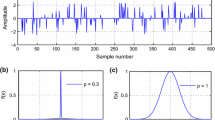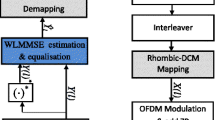Abstract
This paper presents a new method for OFDM channel estimation (CE) using singular spectrum analysis (SSA). In this method, the conventional LMMSE procedure is used for CE and then SSA based optimum low rank approximation is performed on channel correlation matrix. Detailed simulations for bit error rate and mean square error have shown good performance for this algorithm compared to the well-known LSE, MMSE, and SVD based CE methods. In the proposed method, the SSA is also employed for denoising the signal aimed at further improvement in the performance of CE. SSA decomposes the received OFDM symbol into empirical orthogonal functions (EOFs). A de-noised signal is reconstructed using selective EOFs based on Pearson correlation coefficients. The proposed method has outperformed LSE and MMSE based methods and shown an average 2 dB improvements over SVD based method.










Similar content being viewed by others
References
Prasad, R. (2004). OFDM for wireless communications systems. Norwood: Artech House, Inc. Publications.
Marchetti, N., Rahman, M. I., Kumar, S., & Prasad, R. (2009). OFDM: Principles and challenges. In V. Tarokh (Ed.), New directions in wireless communications research. Boston, MA: Springer.
Edfors, O., Sandell, M., van de Beek, J. J., Wilson, S. K., Börjesson, P. O., et al. (1997). OFDM channel estimation by singular value decomposition. IEEE Transactions on Communications, 46(7), 931–939.
Dong, X., Lu, W. S., Soong, A. C. K., et al. (2007). Linear interpolation in pilot symbol assisted channel estimation for OFDM. IEEE Transactions on Wireless Communications, 6(7), 1910–1920.
Qi, C., Wu, L., et al. (2012). A study of deterministic pilot allocation for sparse channel estimation in OFDM systems. IEEE Communications Letters, 16(5), 742–744.
Dai, L., Wang, Z., Yang, Z., et al. (2013). Spectrally efficient time-frequency training OFDM for mobile large-scale MIMO systems. IEEE Journal on Selected Areas in Communications, 31(2), 251–263.
Zhang, W., Xia, X. G., Ching, P. C., et al. (2006). Optimal training and pilot pattern design for OFDM systems in Rayleigh fading. IEEE Transactions on Broadcasting, 52(4), 505–514.
Xie, H., Andrieux, G., Wang, Y., Diouris, J., Feng, S., et al. (2014). Efficient time domain threshold for sparse channel estimation in OFDM system. AEU-International Journal of Electronics and Communications, 68, 277–281.
Van de Beek, J. J., Edfors, O., Sandell, M., et al. (2000). Analysis of DFT-based channel estimators for OFDM. Wireless Personal Communications, 12(1), 55–70.
Pallaviram, S., Chandra Mohan, B., et al. (2015). A pilot aided channel estimator using DFT based time interpolator for massive MIMO-OFDM systems. AEU-International Journal of Electronics and Communications, 69, 321–327.
Hoeher, P., & Tufvesson, F., et al. (1999). Channel estimation with superimposed pilot sequence. In IEEE global telecommunications conference (GLOBECOM’99) (pp. 2162–2166).
Al-Naffouri, T., et al. (2007). An EM-based forward-backward Kalman filter for the estimation of time-variant channels in OFDM. IEEE Transactions on Signal Processing, 55(7), 3924–3930.
Liu, Y., Tan, Z., Hu, H., Cimini, L. J., Li, Y., et al. (2014). Channel estimation for OFDM. IEEE Communications Surveys & Tutorials, 16(4), 1891–1908.
Mokhtar, B., Bouzidi, D. A., et al. (2015). New design of pilot patterns for joint semi-blind estimation of CFO and channel for OFDM systems. AEU-International Journal of Electronics and Communications, 69, 759–764.
Liang, Y., Luo, H., Yan, C., & Huang, J., et al. (2006). Channel estimation using adaptive filters in MIMO-OFDM Systems. In International conference on wireless communications, networking and mobile computing, 2006 (WiCOM 2006) (pp. 1–4).
Zhang, W., Gao, F., Yin, Q., et al. (2015). Blind channel estimation for MIMO-OFDM systems with low order signal constellation. IEEE Communications Letters, 19(3), 499–502.
Beygiharchegani, S., Mitra, U., et al. (2015). Multi-scale multi-lag channel estimation using low rank approximation for OFDM. IEEE Transactions on Signal Processing, 63(18), 4744–4755.
Liu, H., Cong, W., Wang, L., Li, D., et al. (2017). Symbol error rate performance of nonlinear OFDM receiver with peak value threshold over frequency selective fading channel. AEU-International Journal of Electronics and Communications, 74, 163–170.
Kari, D., et al. (2017). Robust adaptive algorithms for underwater acoustic channel estimation and their performance analysis. Digital Signal Processing, 68, 57–68.
Pallaviram, S., & Chandra Mohan, B. (2017). A survey on OFDM channel estimation techniques based on denoising strategies. Engineering Science and Technology, an International Journal, 20, 629–636.
Krishna, E. H., Sivani, K., & Reddy, K. A. (2014). On the use of singular spectrum analysis for OFDM channel estimation. In Proceedings of international conference on electronics and communication systems (ICECS), Coimbatore, India, 13–14 February, 2014 (pp. 1–4).
Broomhead, D. S., King, G., et al. (1986). Extracting qualitative dynamics from experimental data. Physica D: Nonlinear Phenomena, 20, 217–236.
Broomhead, D. S., King, G., et al. (1986). On the qualitative analysis of experimental dynamical systems. In S. Sarkar (Ed.), Nonlinear phenomena and chaos (pp. 113–144). Bristol: Adam Hilger.
Allen, M., Smith, L. A., et al. (1997). Optimal filtering in singular spectrum analysis. Physics Letters, 234, 419–428.
Author information
Authors and Affiliations
Corresponding author
Additional information
Publisher's Note
Springer Nature remains neutral with regard to jurisdictional claims in published maps and institutional affiliations.
Rights and permissions
About this article
Cite this article
Hari Krishna, E., Sivani, K. & Ashoka Reddy, K. New Channel Estimation Method Using Singular Spectrum Analysis for OFDM Systems. Wireless Pers Commun 101, 2193–2207 (2018). https://doi.org/10.1007/s11277-018-5811-5
Published:
Issue Date:
DOI: https://doi.org/10.1007/s11277-018-5811-5




